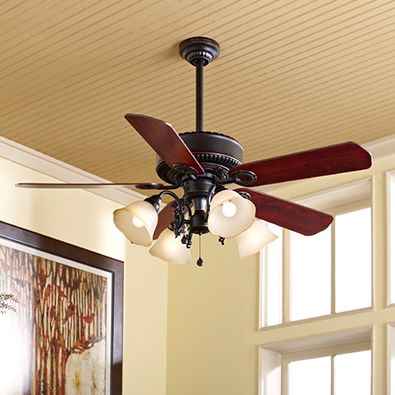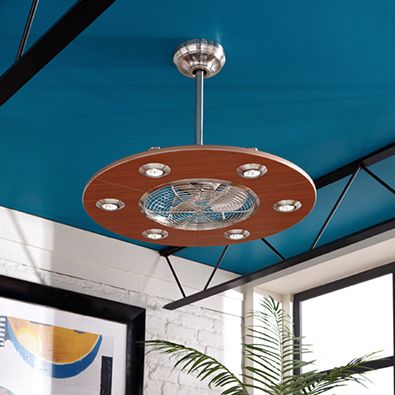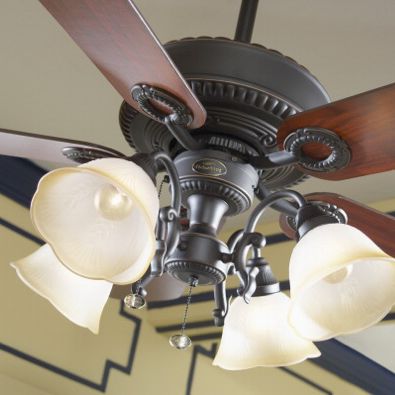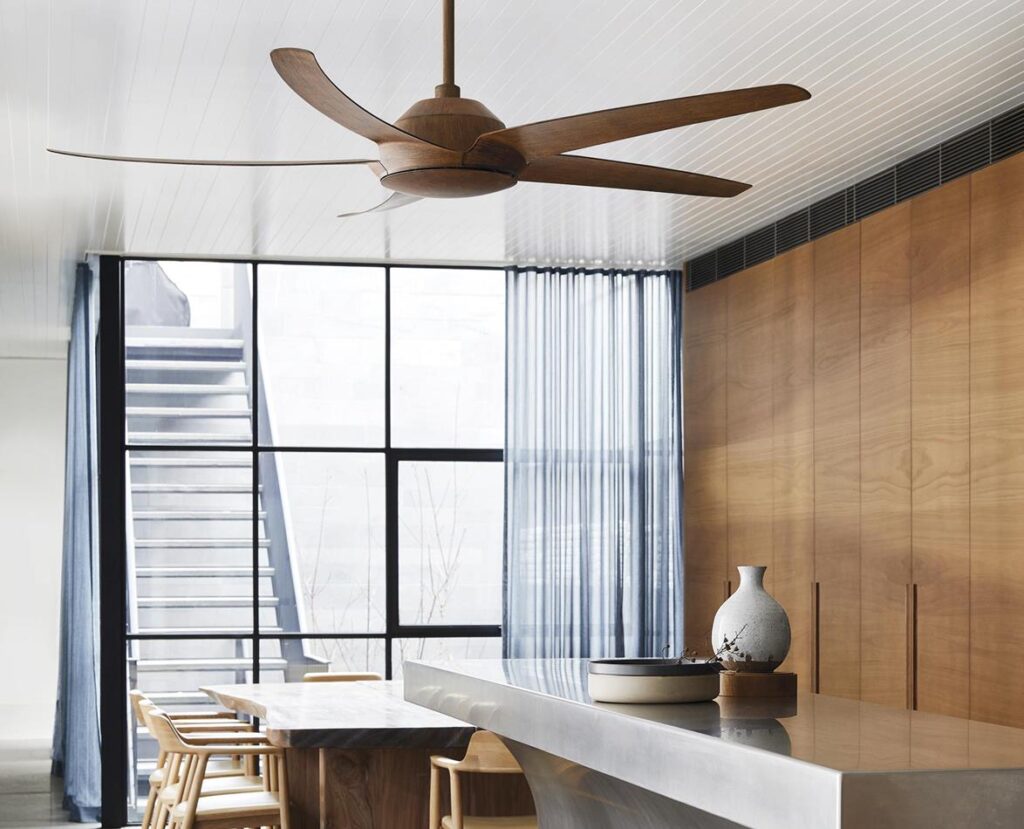How to Choose the Right Ceiling Fan
Most of us don’t think twice before heading off to the shops and buying the first ceiling fan that pleases the eye. At least for me, buying a ceiling fan for the home is a minor detail as compared to say, picking the right lights or choosing the colour of curtains. As it turns out, as if the myriad choices now available aren’t enough to confuse us (growing up, the standard three-blade white fan was a fixture in every home), there is actually a science behind choosing the right ceiling fan. Read these questions and answers to get your money’s worth the next time you need to buy a ceiling fan.
What size ceiling fan should I buy?
The size of the room would determine how big your ceiling fan should be. Fan size is measured by its diameter (blade span), which should be proportional to the space. A fan that’s too small for a room might not stir up enough air and one that’s too big could create a mini hurricane of sorts.
How high up should I hang my ceiling fan?
A fan needs to be suspended 2.4 to 2.7 metres off the ground for optimum air circulation. Do consider the size of the room before deciding on the type of fan – either a hugger fan or a fan with a downrod. Hugger fans, true to their name, hug the ceiling and are meant for low ceilings. Ideal for rooms with ceilings at least 2.4 metres high, they are mounted flush to the ceiling with no extra attachments. A space of 30 centimetres is the minimum required between ceiling and fan.
What’s with the different number of blades?
More is not merrier in this case. The number of blades a fan has is more an element of design than functionality. There is little difference between the performance of a three-, four- or five-bladed fan, so choose one based on preference and style
Does blade material make a difference?
Blades can be metal (stainless steel or aluminium), wood (timber, plywood or MDF) or PVC or plastic. There’s no difference in performance, so feel free to choose one that complements your sense of style, but ensure it’s of good quality. A high-quality finish will resist corrosion, blistering and fading. A good metal finish will not need polishing for several years and good-quality plastic finishes will stay thick and durable for many years

Ceiling Fan Buying Guide
Choose the Right Ceiling Fan for Your Space
A ceiling fan’s primary purpose is to circulate air in a room. Air conditioners chill air, but ceiling fans push it around, which means they’re useful for both cooling and heating. In a bedroom, a ceiling fan encourages restful sleep without running the air conditioning. On an open or screened porch, a ceiling fan can create a refreshing retreat — just be sure it’s rated for damp or wet locations. Look for outdoor fans with weatherproof fan blades, too. Both types can handle moisture, but damp-rated fans shouldn’t come in contact with water. Wet-rated fans are suitable for coastal or rainy areas.
Ceiling Height
When selecting a new or a replacement ceiling fan, keep in mind the ceiling height. The ideal fan height from floor to fan blades is approximately 8 feet. Many fans have multiple mounting options, allowing them to work almost anywhere in the home. Measure the height of your ceiling to determine the mounting option that’ll work best for your space
Mounting Options
Flush Mount: Made for rooms with low ceilings where a low profile is wanted or required. These ceiling fans are mounted flush to the ceiling, with no extra attachment
Ceiling Fan Blades
The look of a ceiling fan’s blades are actually more of a design feature than a matter of efficiency or utility. The fan’s ability to move air is determined by the pitch of the blades, so pick the one you like the look of best. Many fans come with reversible blades so if you get tired of one finish, you can reverse them later. Talk about an effortless design update. The number of blades and blade shapes are also getting a makeover. Some fans have as many as nine blades, for a helicopter style; however, the traditional four- to five-blade ceiling fans remain classic.
Ceiling Fan Direction in Summer and Winter
Change the ceiling fan direction to make it more comfortable year-round, and save energy and money by adjusting your thermostat. In the summer, set the fan blades to revolve in a counterclockwise direction as you look up at it to create a downward motion and a cooling effect. Doing this also raises the thermostat temperature, which will reduce your air conditioner’s workload.

How to choose the best ceiling fan
Ceiling fans are a great way to stay comfortable when the temperature rises. They can work in tandem with your air conditioning to circulate cool air, or as a cost-effective alternative. When choosing the best ceiling fan for your space, there are a few things you might want to consider.
What size ceiling fan
It might sound obvious but the basic rule is the larger the room, the bigger the fan required. For a small room (up to 20 square metres) fans with blades up to 122cm are ideal. For a bigger room, you’ll probably want to look for a fan with blades that are 130cm or more
Take control
Generally, there are two options when it comes to controlling your fan. Either a wall switch with a dial to vary the speed, or a remote control if access to the roof and wiring is an issue
Three or four blade ceiling fans
Most fans have either three or four blades and are made of either plywood, metal or plastic. The number of blades has no effect on their ability to cool a room but timber and plastic blades do tend to be a little quieter than metal.
Finish and colour
Another factor worth considering is how your fan is going to look within a room, as they can become a dominant feature. This is not too much of an issue if it’s going to be installed in an outdoor area, but for indoor fans it’s worth thinking about how it will complement your colour scheme and décor.

Ceiling fans: a guide to choosing the right one
The ceiling fan is one of those household essentials in which form and function can be perfectly married. The latest styles range from graceful good looks to fabulous statement-makers, and they’re useful year-round to help keep you cooler in summer and warmer in winter. Here’s what you need to know.
SIZE MATTERS
When it comes to ceiling fans, size is actually everything. “A small fan in a large room will have to work twice as hard to cool you off, while a large fan in a small room may create an uncomfortable amount of airflow,” says Beacon Lighting’s Denise Hammond. For a small to medium-sized room up to 4m x 5m, select a fan with 122cm blades, suggests Denise, while blades of 132cm-plus will suit a room size of up to 6m x 6m. In a large, open-plan space, you may need two or more models.
It’s less the number of blades than the shape of the aerofoil that truly determines the effectiveness of the fan, explains Sarah Johnston of Big Ass Fans. “Our aerofoil design includes an upswept blade angle, that has been designed to provide greater air flow and therefore more effective coverage of a room in comparison to traditional ceiling fans,” she says.
PERFECT POSITIONING
“Blades need to be at least 2.1m from the floor,” says builder Patrick Toner of All Things Building, so if you have low or standard 2.4m ceilings you’ll need to look for a low-profile model that can be fitted flush to the ceiling. “Most fans come with a ball canopy fixing method, which means fans can be mounted on sloping, vaulted or flat ceilings,” explains Denise. For high or raked ceilings, an extension rod might be necessary to actually bring the fan down to an efficient height.
POWER BENEFITS
Fans don’t cool the air, they just move it around the room. “The faster the air moves over your skin, the more it works to evaporate perspiration, which is the mechanism your body uses to cool itself,” explains Denise Hammond. A ceiling fan demands just a fraction of the power needs of an air conditioner, and using both together can reap serious energy-saving benefits. “The two work well in tandem by dropping the initial temperature of a room, and then circulating that colder air,” says Denise.

How to Choose the Right Size Ceiling Fan for Your Room
There’s more to choosing a ceiling fan than grabbing one you like off the shelf. It first begins with understanding the height, size and type. Follow the steps to properly measure to get the right fit.
Determine the correct blade span for the room
It seems obvious that you want a smaller ceiling fan for a smaller room and a larger ceiling fan for a larger room. But for best performance, you need a ceiling fan with the correct blade span for the room. If the fan has an odd number of blades, measure from the center of the fan to the end of one of the blades and multiply the number by two. If the fan has an even number of blades, measure from one end of a blade to the end of the blade on the opposite side.
Determine how high to hang your fan
How high you hang your ceiling fan and the type of mount you need depends on the height of your room and whether or not the ceiling is sloped. Hanging your ceiling fan at the right height will give you the best airflow.
Determine the right downrod
Choosing the right downrod is important so that you can mount your ceiling fan at a safe distance from your head
For sloped ceilings:
A sloped ceiling requires a slope mount to hang a ceiling fan. Make sure the fan is mounted at the middle of the room at an appropriate height. The distance from the floor to the fan blades must be minimum 8 feet.